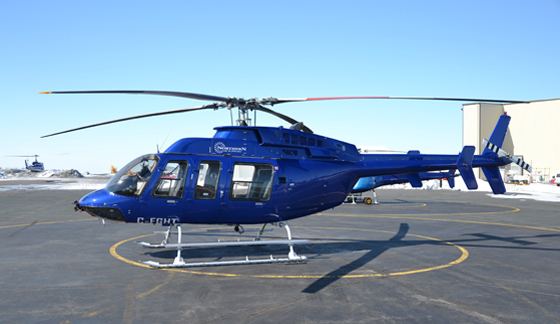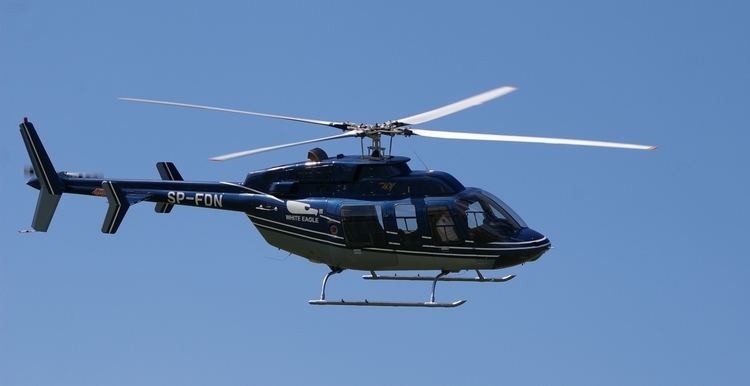Wingspan 11 m Range 598 km Weight 1,210 kg Engine type Allison Model 250 | Length 13 m Cruise speed 246 km/h Top speed 259 km/h | |
 | ||
Bbm 407 gt helicopter bell 407 variant
The Bell 407 is a four-blade, single-engine, civil utility helicopter; a derivative of the Bell 206L-4 LongRanger. The 407 uses the four-blade, soft-in-plane design rotor with composite hub developed for the United States Army's OH-58D Kiowa Warrior instead of the two-blade, semi-rigid, teetering rotor of the 206L-4. The Bell 407 is frequently used for transport, as an air ambulance, and for law enforcement, electronic news gathering and movie making.
Contents
- Bbm 407 gt helicopter bell 407 variant
- Bell 407ah weaponized combat attack helicopter at sofic 2013
- Design and development
- ARH 70 and Bell 417
- Bell 407GX and 407GT
- Operational history
- Variants
- Operators
- Military operators
- Specifications Bell 407
- References

Bell 407ah weaponized combat attack helicopter at sofic 2013
Design and development

In 1993, Bell began the development of the New Light Aircraft as a replacement for its Model 206 series. The program resulted in the 407, a development of Bell's LongRanger. A 206L-3 LongRanger was modified to serve as the 407 demonstrator. The demonstrator used hardware for the 407 and added molded fairings to represent the 407's wider fuselage then under development.

The demonstrator was first flown on April 21, 1994, and the 407 program was publicly announced at the Heli-Expo in Las Vegas, Nevada, in January 1995. The first 407 prototype (C-GFOS) accomplished its maiden flight on June 29, 1995, and the second prototype (C-FORS) followed on July 13, 1995. After a short development program, the first production 407 (C-FWQY/N407BT) flew on November 10, 1995.

The Bell 407 features the four-blade main rotor developed for the OH-58D (Model 406). The blades and hub use composite construction without life limits, and provide better performance and a more comfortable ride. The 407's fuselage is 8 inches (18 cm) wider, increasing internal cabin space, and includes main cabin windows that are 35% larger. The more powerful Rolls-Royce/Allison 250-C47 turboshaft allows an increase in Maximum Takeoff Weight and improves performance at hotter temperatures and/or higher altitudes. The 407's airframe is generally similar to the LongRanger, but includes a carbon fiber composite tailboom. The helicopter has standard seating for two crew and five cabin seats.
The 407 was certificated by Transport Canada on February 9, 1996, with the FAA following shortly after on February 23. Full production began in 1996 at Bell's Mirabel, Quebec, Canada plant and produced 140 airframes in 1997, to fill the initial orders.
In 1995, Bell tested a shrouded tail rotor on the 407, but did not proceed with it. For a time, Bell studied developing the Model 407T twin-engine variant, but instead chose to develop the essentially all-new twin-PW206D powered Bell 427.
Bell began deliveries of the 407 in 1996. The 1,000th helicopter was delivered on June 15, 2010.
ARH-70 and Bell 417
The ARH-70 armed reconnaissance helicopter, developed for the U.S. Army was based on the 407, but was later canceled on October 16, 2008.
The Bell 417 was a growth variant of the Bell 407, in essence a civil version of the Bell ARH-70. The 417 made its first flight on June 8, 2006. The 417 was to be powered by a Honeywell HTS900 turboshaft engine, producing 970 shp (720 kW) and includes full FADEC controls. The cabin sat five passengers in club-seating configuration, in addition to the crew of two. The civilian 417 was canceled at Heli-Expo 2007 in Orlando.
Bell 407GX and 407GT
On March 4, 2013, Bell unveiled a new armed version of the Bell 407GX, named the 407GT. It incorporates the Garmin G1000HTM flight deck to easily provide flight information. It can include infrared cameras, various armaments, and equipment to perform different missions such as armed transport, search-and-rescue, reconnaissance, and medical evacuation. The GT version uses the universal weapons pylon (UWP), derived from the Bell OH-58 Kiowa, to carry different weapons including machine guns, rockets, and anti-armor missiles.
Operational history
Bell made delivery of the first production 407 at Heli-Expo, in Dallas, Texas in February 1996. Launch customers for the aircraft were Petroleum Helicopters, Niagara Helicopters, and Greenland Air.
On 23 May 2007, Colin Bodill and Jennifer Murray completed a record pole-to-pole around the world flight utilizing a standard Bell 407. The flight originated from Bell's facility at the Fort Worth Alliance Airport on December 5, 2006. The team flew about 36,000 miles (58,000 km) over 189 days and 300 flight hours, through 34 different countries. The project, named Polar First, was performed in partnership with the Royal Geographical Society to provide educational outreach to 28 international schools, which were visited during the trip. The project also served as a fundraiser for the SOS Children's Villages.
In 2009 the Iraqi Air Force ordered three Bell 407 armed scout helicopters (similar to the canceled ARH-70). A contract for 24 additional Bell 407s with an option for 26 more was awarded in April of that same year. The U.S. Army is managing modifications and installation of military equipment on the helicopters. Three training T-407s were delivered to the Iraqi Army in 2010. Armed IA-407s were delivered in eight batches of three aircraft from August 2012 to April 2013. The final Bell 407 for Iraq was delivered on 3 April 2013. There are 30 in service; 24 armed scouts, three gunships, and three trainers.
Iraq is using the IA-407 in operations against Islamic State militants. On October 8, 2014, militants shot down an IA-407 using a shoulder-fired ground-to-air missile, killing the pilot and co-pilot.
Variants
Operators
The Bell 407 is in civil service around the world with airlines, corporations, hospitals, government operators and private individuals. It is also in service with several military operators.
Military operators
The Bell 407 is currently being flown by the following military operators:
Specifications (Bell 407)
Data from Bell 407
General characteristics
Performance
